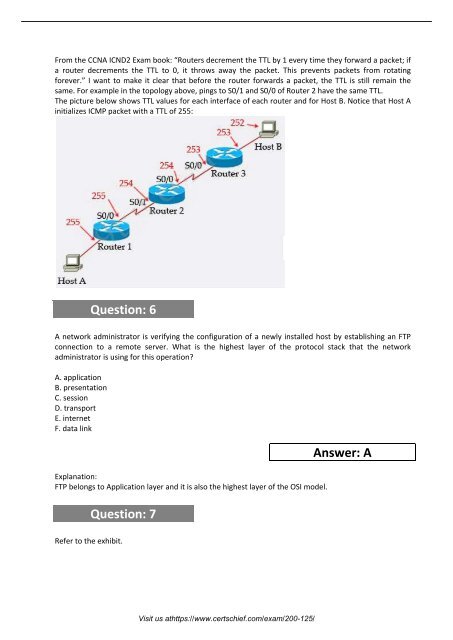200-125 Practice Test Software
Study kits and preparation materials provided by us for 200-125 Test are authorized by the professionals and industry experts. You can easily pass your certification test with our brain dumps and PDF sample questions. For more info please visit here: https://www.certschief.com/exam/200-125/
Study kits and preparation materials provided by us for 200-125 Test are authorized by the professionals and industry experts. You can easily pass your certification test with our brain dumps and PDF sample questions. For more info please visit here: https://www.certschief.com/exam/200-125/
You also want an ePaper? Increase the reach of your titles
YUMPU automatically turns print PDFs into web optimized ePapers that Google loves.
From the CCNA ICND2 Exam book: “Routers decrement the TTL by 1 every time they forward a packet; if<br />
a router decrements the TTL to 0, it throws away the packet. This prevents packets from rotating<br />
forever.” I want to make it clear that before the router forwards a packet, the TTL is still remain the<br />
same. For example in the topology above, pings to S0/1 and S0/0 of Router 2 have the same TTL.<br />
The picture below shows TTL values for each interface of each router and for Host B. Notice that Host A<br />
initializes ICMP packet with a TTL of 255:<br />
Question: 6<br />
A network administrator is verifying the configuration of a newly installed host by establishing an FTP<br />
connection to a remote server. What is the highest layer of the protocol stack that the network<br />
administrator is using for this operation?<br />
A. application<br />
B. presentation<br />
C. session<br />
D. transport<br />
E. internet<br />
F. data link<br />
Explanation:<br />
FTP belongs to Application layer and it is also the highest layer of the OSI model.<br />
Question: 7<br />
Answer: A<br />
Refer to the exhibit.<br />
Visit us athttps://www.certschief.com/exam/<strong>200</strong>-<strong>125</strong>/
















